So let me begin with a story. This is the story of someone who was carrying $11,000 of cash in his suitcase, because, as he informed me, he was “used to carrying lots of cash with him.” You know what thieves are used to? Thieving.
Several people have asked me about money belts in the past, and I find them immensely useful for keeping items safe and secure. If you’ve ever lost a wallet on a trip to another country, you’ll know that it’s a huge hassle dealing with getting it all back, especially if you’re trying to make phone calls to cancel the cards, or reactivate the replacements, and they put you on hold repeatedly for 20 minutes at a time and you have to pay international calling rates for the privilege of doing so.
(And yes, that’s exactly what happened. I won’t call out the bank in question, because that would be rude. But it starts with Bank and ends with of America. The bastards.)
So anyway, what’s so great about money belts? Well, they fit underneath your clothing, so they’re lot harder for pickpockets to find, and thus more likely to keep your cash, credit cards, and passport safe from getting lost or stolen. If you’re going somewhere with a reputation for pickpockets, it’s a good idea to bring one along. Travel pants with safety pockets are a great option as well, but you can buy a money belt for as little as $10, which is a lot easier for most people.
One thing you don’t want to do is put everything in there, as you don’t want to lose everything all at once. What I generally suggest is for people to split things up into at least two places: A money belt, with cash, a credit card, and a single ID (probably a passport), and a wallet, with cash, a credit card, and a second ID (probably a driver’s license). That way if you lose one or the other, it won’t be such a big deal handling the next few days of eating, sleeping, and dealing with it all. You can go further and split things up even more, but you should at least go this far (and also carry a photocopy of your passport somewhere totally separate, like in your bag).
So! With all the options out there, which one is right for you? Here’s what I think about all the major designs, and how they compare:
Money belts 101
1) The waist pouch
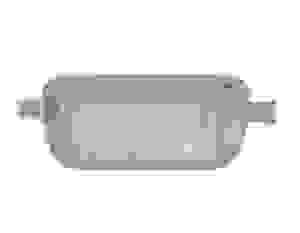
This is probably the most popular method, and the most versatile. It’s a simple pouch that hangs around your waist, and tucks into your pants. It’s nicely concealed, but still easily accessible; you can just reach in and pull it out, and tuck it back in when you’re done.
The larger size also helps with longer documents, like plane tickets, though some of the lengthier designs will get annoying for smaller people, as the edges will start digging into your legs. Check the dimensions first, but also remember that it’ll be mostly flexible; passports will probably be the only stiff thing in there.
Pros:
- Easily concealed
- Easily accessible
- Designs usually feature multiple compartments
- Long design can fit longer documents (like plane tickets)
Cons:
- Sometimes a little too long
- Not directly attached to anything, so if it’s unclipped, it’s no longer secure
- Make sure you get one with a good clip; some of of the flat-clip designs (the ones that look kind of like a seatbelt clip) can unclip themselves (the one pictured above does not have this problem)
- You need to get it out of the way to use the bathroom
2) The belt loop pouch
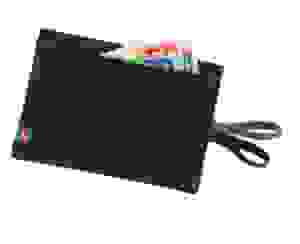
This one loops onto a belt, and then you tuck it into your pants. This is a bit more secure than the option above, since it can’t be easily removed, unless you remove the belt, or cut the cord.
Though not quite as simple to operate as the waist pouch (removing it and inserting it is a bit trickier), it’s still pretty simple, and smaller, too. The double-loop options allows you to use it with a black or brown belt, and it’ll blend in a little better. You can also use it without a real belt, by clipping a carabiner onto a pant belt loop, if necessary.
Pros:
- Better secured, by hanging directly from a belt
- Fairly easy to conceal and remove
- Generally made with multiple compartments
- Smaller than many other designs, but still big enough for a passport
Cons:
- Slightly trickier to operate than a waist pouch
- Detaching it altogether isn’t as quick, since it’s attached to a belt
3) The neck pouch
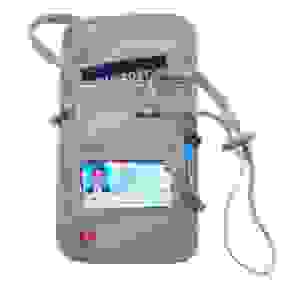
This one looks great in theory, but it’s a little trickier than you might think at first. You wear it around your neck, under a shirt. Accessing it therefore requires you to lift up your shirt, which can bring some unwanted attention. It also means that in hot environments, you’re wearing it right next to your skin, which can get icky. Plus the strap is usually visible, as it appears on the back of your neck, depending on what kind of shirt you’re wearing…so it’s not easily accessible, not always properly concealed, and potentially uncomfortable.
It’s not all bad, though. If you’re traveling somewhere relatively cold, and therefore will be wearing multiple layers, you can wear it in between those layers; over a t-shirt, but under a sweater, for example. This prevents it from feeling uncomfortable against the skin, and if the sweater has a high collar, it’ll block it from view. If it’s a full-zip sweater, you’ll be able to access it pretty easily through the zip. Another good method is to use this with a collared shirt and an undershirt, with the pouch stashed between those two layers. Again, the undershirt keeps you comfortable, the high collar blocks it from view, and you can undo a few buttons to get access to the pouch. In situations like those, this’ll be fine.
Pros:
- Multiple compartments
- Easily attachable and removable (if worn just around the neck)
Cons:
- Not so comfortable against the skin (so wear an undershirt, and put this on top)
- Not entirely secure if worn just around the neck (wearing it over just one shoulder is safer, but harder to remove)
- Strap can be visible up by the neck (wearing a collared shirt or a sweater with a high collar helps prevent this)
- Not easily accessible without lifting up a shirt (use with a buttoned shirt or a zip-up sweater to make it more accessible)
4) An actual belt
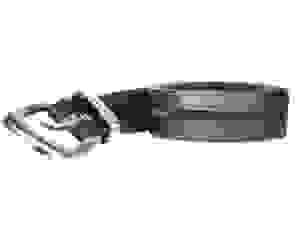
This one, as you might guess, is the most secure, but the least accessible, and with the least amount of storage.
As you can probably tell, you can’t fit much in there. You can get folded-up paper money in there, but no passport or credit cards. You can, however, fit copies of passports in there, folded up along with the cash. That’ll give you a spare document in case the original gets lost.
It’s not so easy accessing this while you’re out and about, so it’s probably a good place for storing backup cash that you don’t plan on spending immediately. You’ll probably still want another method for securing documents and credit cards, so I would generally recommend this one in addition to one of the other methods listed here, or along with travel pants with secured pockets.
Pros:
- Super-duper secure
Cons:
- Not much storage; usually best to use in conjunction with another money belt where you’ll store cards and passports
- Usually pretty weird looking…the above photo is one of the few leather belt versions available, which looks more normal. The rest are usually nylon webbing, so they look a little weird; check out Bison Designs for some nice-looking options, though.
- Someone should make that buckle out of carbon fiber so you can go through airport security metal detectors without removing it
5) The leg stash
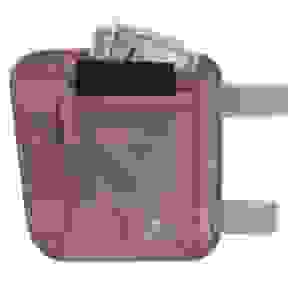
This one seems cool, but has some awkwardness problems.
Notice how it’s big enough to fit a passport? That’s great, except that passports are flat, and your legs are round. Your passport will get deformed if you store it in there.
That’s not necessarily bad, but until your passport gets deformed, it’ll be a little tricky sliding a flat passport into a curved chamber.
Grab your passport and squish it against your calf muscle. If it feels fine, then maybe this’ll work. It’s most likely to work better for people with larger legs, since your passport will fit more flatly against it, and you’ll be able to tighten the straps nicely (I was actually too skinny to get a tight fit with the one I tried). It’s also possible to wear this loosely around your ankle, which isn’t so bad, but might feel kinda weird. Plus, this is only for pants, not shorts, as it’s supposed to fit around the calf, not the thigh.
All in all, it’s not bad, but I expect it’ll feel better on certain body types, so try it out before you commit.
Pros:
- Easily concealable (with pants)
- Still fairly easily accessible
- Multiple compartments
Cons:
- Can’t be used with shorts
- Will probably fit better on certain body types (larger is probably better)
- Slimmer-fitting pants might feel awkward with it
6) A keyring wallet
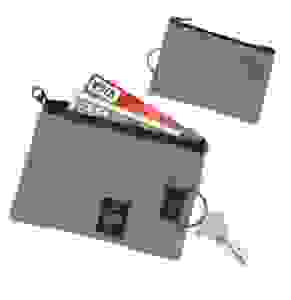
This is essentially a miniature version of the belt loop pouch listed above, and I’m pretty sure the people making it have no idea how useful this could be as a travel wallet, because all they think the keyring is for is for attaching keys. But if you loop the keyring onto a belt loop and tuck it into your pants, you get an easily-accessible wallet that’ll pop out whenever you need it, and tuck away when you’re done.
You can do this by feeding the keyring through the belt loop itself, or with an additional carabiner or short length of paracord or other really strong nylon string of some kind. There’s a double-zip version out there too, for even better organization.
I’ve seen some other designs that actually try to make a wallet like I’m describing, with a carabiner or a clip of some kind pre-installed, but I think adding some paracord to this keyring is actually more functional than some of the alternatives I’ve seen.
Pros:
- Easily accessible
- Easily concealable
- Can be securely attached to a belt loop, or a belt (the easiest way would be with some paracord)
Cons:
- Small; only good for cash and cards
- You’ll need your own carabiner or paracord loop, unless you use the keyring-directly-on-the-belt-loop method (which isn’t quite as simple to operate or detach)
7) The bra stash

Ladies, this one’s for you. It’s tiny and discreet, and incredibly simple. You just clip it onto a bra strap (either centered or along the side), and that’s it.
These are usually quite small, just big enough for credit cards and folded-up cash, so passports will have to go somewhere else. I’ve seen some big enough for a passport, but I don’t think that’s going to be comfortable or well-hidden, so again, this is the type of thing that should be used in conjunction with something else. Still, it’s nice to be able to bring a secret wallet along for a night out without needing to bring a full-size money belt.
Beware, however, that there are stories out there of the snap coming undone by itself. While you’re wearing it, it probably won’t be a big deal, since it’ll be snugly pressed against you, but keep an eye on it when you’re changing clothes.
Pros:
- Tiny and discreet
- If anyone’s looking in there, you’ll probably know about it
Cons:
- Usually too small for a passport
- Not super-securely attached; it helps to be a little paranoid about the snap unsnapping itself
Summing up
Well, that just about covers the major options out there. Hopefully this’ll give you an idea of the pros and cons of each major design. I’ve used several of these, and it’s usually not until you’re a few days into a trip that you start running into the quirks of one particular design or another. I would still say the waist pouch is the most versatile design, and the most likely to work for most people, but the alternatives have plenty going for them as well.
One last thing, about RFID: Credit card scammers can use a machine that can read the magnetic strip on a credit card, just by walking right by. You won’t know they stole your credit card number until after they start buying things with it. This is definitely a concern, but I think that as credit card with microchips become more common, this strategy will become less and less useful, so I wouldn’t get too worked up about it. Several of the above options do have RFID blockers, though, so you’ll be safe from that particular problem.




There’s an XKCD relevant here:
http://imgs.xkcd.com/comics/security.png
Point being, someone in another country (with friends no doubt) wants your stuff, they’ll get it from you by force. Best to just get something comfortable and thats “just enough” to deter the easy people and be aware during the rest, so you can have comfort and not spend your life worrying about having something cut on your belt.
Very true. That’s why I like small, easy solutions, like hidden zippered pockets, or small money belts. Nothing’s going to be perfectly safe, but small details like those can help.
I was living in Europe for years and I always had at minimum one bill equal to taxi money hidden on me so I never had to worry or risk my well being getting home. ID and bill small as possible in the very bottom of your pocket, fold it under against body and safety pin it together. Works great no retrofitting what you have. If there are no pockets, I had a simple rectangle piece of fabric that I sewed to form a pocket and pin inside whatever I was wearing. I never lost any of my stuff and believe me I felt hands wandering trying to target me especially during those blasted metro strikes. I was in Barcelona after all, capital of the “chorizo” local slang for pickpocketer.
I like the idea of hiding cab fare somewhere on your body. That’s pretty clever.
Your article was great, but seemed to put emphasis on accessing security belts. In my experience, things in security belts stay there and stay hidden.
Put things you don’t want to access on a daily basis (but do need) such as your passport, a credit card and some money in a security belt. And leave it there!
If you access your hidden pouch in public you’re highlighting to the pickpockets where to find your valuables.
If you must access your security belt, find a dark corner/toilet/shop changing cubicle and get out what you need there.
Any money or items you need that day can go in a regular wallet, just like you’d use at home. Take care with that, just like you would at home.
That certainly makes sense. It’s more about carrying it securely than accessing it easily. Still, I wanted to mention it as an issue to think about anyway.
There is a new product called Möbius Belt that can help solve some of the comments made earlier. It’s actually super comfortable to wear under clothing and keeps valuables safe and stored away when traveling. Möbius Belt can be used for other activities as well. It gives you pockets when on the go and keeps hands free. Check it out at http://www.mobiusbelt.com
Hi, I habitually carry my wallet in my hip pocket, right side. When I travel I carry valuables elsewhere but still carry a cheap nylon wallet in my hip pocket. This is because when bumped by someone it is automatic to check if your wallet has been lifted, thus giving away its position. The dummy wallet carries a couple of Egyptian pounds, some expired store loyalty cards, and a note to the thief as polite or otherwise as you wish to make it. Useful for muggers too.
Have you tried the detachable, secure and water-resistant ‘pock-its’ that attach to comfy bamboo undies for both women and men? You can attach in 3 different spots.
You can get them at https://65fifty5.com/
I used to use a money belt or a hidden pocket, but find these better as they sit flat, and can be taken off when I don’t need a pocket & they become regular undies. I use them to store my passport, and cash I won’t be using plus an emergency credit card.
That’s not a bad idea. Very low-profile and no extra straps.
I know this article isn’t really about this, but just to clarify that contactless payments use a single use key via RFID – your credit card details can’t be copied just by someone tapping on it.
A payment however, can be made by simply tapping but as that device would have to be a registered merchant device to actually take a payment I’m not aware of it happening in reality.
If you’re talking about some other device that can literally read mag strips at a distance than that is not RFID tech and isn’t common in the UK at least.